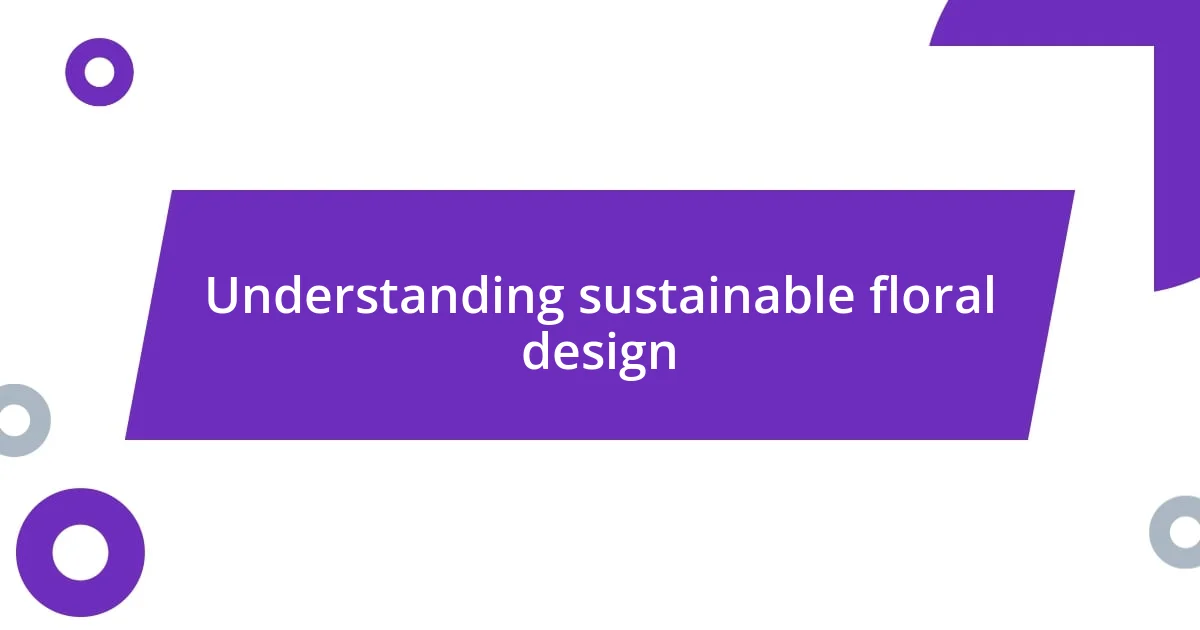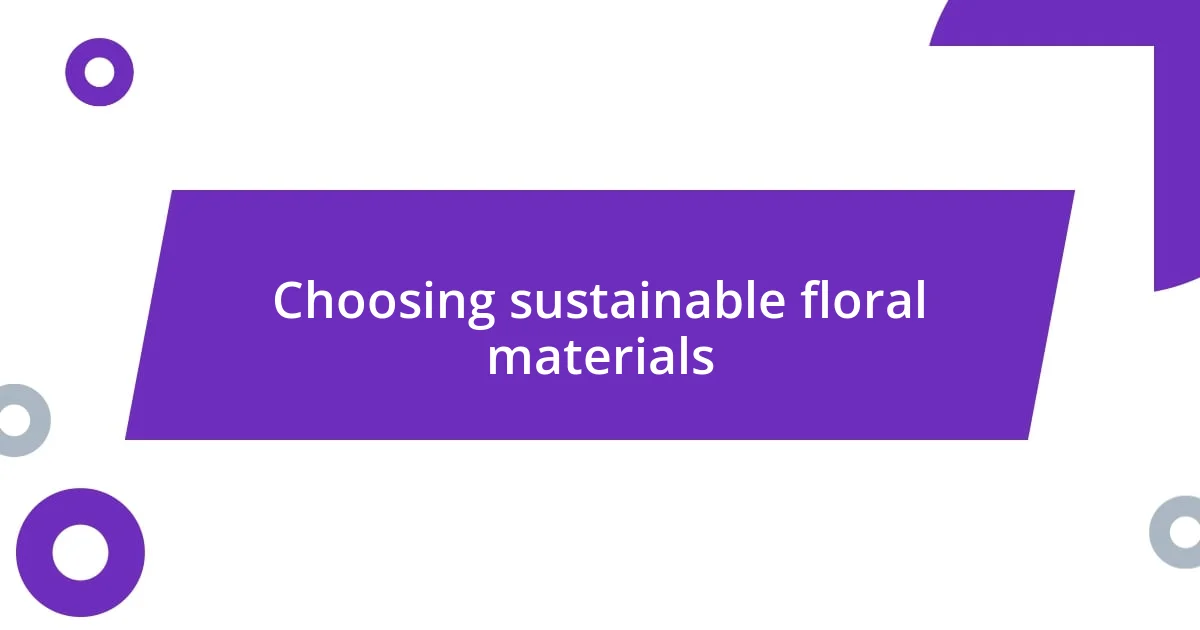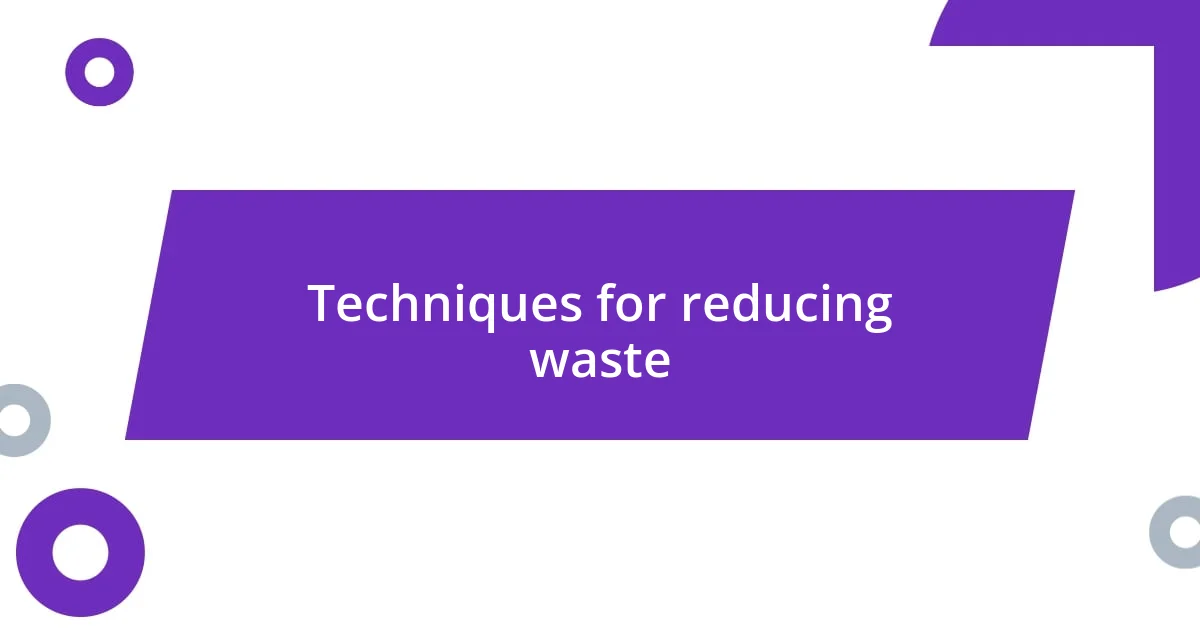Key takeaways:
- Sustainable floral design focuses on eco-friendliness and ethical sourcing, emphasizing local growers and seasonal blooms.
- Utilizing eco-friendly materials and repurposing elements reduces waste, enhances creativity, and supports community connections.
- Educating clients about sustainability fosters awareness, promoting mindful choices and transforming floral design into an ongoing experience.

Understanding sustainable floral design
Sustainable floral design revolves around two core principles: eco-friendliness and ethical sourcing. Whenever I create a floral arrangement, I consciously consider where each bloom comes from. It’s a deeper commitment than just choosing pretty flowers – it’s about supporting local growers and minimizing the carbon footprint.
I’ve often found myself reflecting on how fleeting beauty can be, especially in floral design. Every time I select seasonal blooms for a project, I feel a connection to the rhythms of nature. Isn’t it fascinating how the changing seasons can inspire different palettes and textures? Using flowers in their prime not only enhances the design but also aligns with sustainability.
The emotional impact of sustainable floral design can’t be overstated. When I see a client’s face light up after learning that the flowers I used are locally sourced and chemical-free, it warms my heart. It sparks a conversation about mindfulness in all aspects of life. How can we not feel a part of something bigger when our choices reflect care for the planet?

Importance of eco-friendly flowers
Eco-friendly flowers play a pivotal role in sustainable floral design. When I opt for flowers grown without harmful pesticides, I not only protect my health but also the well-being of the planet. I remember working on a wedding where the bride insisted on only using organic blooms. Witnessing her delight when she learned about the positive impact of her choices reminded me just how much awareness is growing around this topic.
Supporting local growers is another essential piece of the eco-friendly puzzle. I’ve developed relationships with local farms over the years and it’s incredible how personal these connections can be. When I visit a farm and see the care with which the flowers are grown, I can’t help but feel a sense of pride in using them. This authenticity resonates with clients, and I often see their appreciation when they hear the story behind each bloom.
Choosing eco-friendly flowers also helps reduce waste in our industry. I once worked on a project with a florist who prioritized biodegradable materials and local sourcing. The transformation in our arrangement process was remarkable. We created beautiful pieces without excess packaging or waste, making it a rewarding experience for everyone involved. It’s moments like these that reinforce my belief that sustainability in floral design isn’t merely a trend—it’s essential.
| Aspect | Eco-friendly Flowers | Conventional Flowers |
|---|---|---|
| Impact on Health | Minimal chemicals, safer for handling | Often treated with pesticides, riskier for handlers |
| Support for Local Economy | Boosts local farmers and communities | Contributes to mass production, less local support |
| Environmental Footprint | Lower carbon emissions from transportation | Higher carbon footprint due to long-distance shipping |

Sourcing locally grown flowers
Choosing locally grown flowers has become a cornerstone of my floral design philosophy. Every time I visit a nearby farm, I’m struck by the passion and hard work that goes into cultivating blooms right in our own community. I remember a particularly lovely summer day spent at a local flower farm, where the owner personally walked me through their fields. The vibrant colors, the fragrant air, and the joy in her eyes as she described her farming practices deepened my appreciation for sourcing locally.
When sourcing locally, I often consider several key benefits:
- Freshness: Local blooms are harvested at their peak, meaning they last longer and look more vibrant in arrangements.
- Environmental Impact: By reducing transportation distances, we lower carbon emissions and contribute to a healthier planet.
- Community Connection: Purchasing from local growers supports the economy and fosters personal relationships, ensuring that every flower has a meaningful story behind it.
- Seasonal Variety: I love discovering unique seasonal flowers indigenous to my area that I wouldn’t find elsewhere, adding an exclusive touch to my designs.
These connections truly elevate my work; they transform flowers into stories that bring life and character to my arrangements. Each bloom I incorporate serves as a reminder of the vibrant community I’m so fortunate to be part of, and it fills my heart with gratitude.

Choosing sustainable floral materials
When I select sustainable floral materials, I focus not just on the eco-friendly qualities but also on the beauty of the blooms. I once attended a workshop where a florist shared her journey of finding dye-free grass and foliage. Watching the vibrant greens come alive in arrangements sparked joy and reminded me that natural materials can be just as stunning, if not more so, than chemically treated alternatives. Have you ever considered how the colors and textures of sustainably sourced materials can elevate a design?
I also embrace the art of repurposing when choosing floral materials. For example, I often collect seasonal branches and dried flowers from my garden and local parks. It’s fascinating to see how well these elements blend in with freshly cut florals. One time, I created a stunning centerpiece entirely from foraged materials and garden finds, and the reaction from my clients was overwhelmingly positive. They appreciated the originality, and I felt a deep connection to nature throughout the process.
Lastly, incorporating compostable or biodegradable items in my designs has become second nature to me. I remember crafting a bridal bouquet using flower tape made from natural fibers and wire that decomposes after use. The sheer delight on the bride’s face when she discovered that her bouquet would leave no environmental footprint was priceless. It’s little moments like these that make me realize how important it is to share knowledge about sustainable choices. How often do we think about the lifecycle of the products we use in our art? For me, every detail counts.

Techniques for reducing waste
When it comes to reducing waste in floral design, one of my favorite techniques is to utilize every part of the flower. I once worked on a project where we had extra petals left over from a wedding bouquet. Instead of tossing them aside, I decided to create beautiful flower confetti. The couple loved this creative twist; it not only added a personal touch to their ceremony but also transformed what could have been waste into something truly memorable. Have you ever thought about how much beauty can be created from what might seem like leftovers?
Another approach I’ve incorporated is designing arrangements with longevity in mind. I strive to select flowers that not only look stunning but also have a longer vase life. On one occasion, while preparing for a corporate event, I chose a combination of sturdy blooms like chrysanthemums and alstroemerias. Not only did the arrangements survive well beyond the event, but many guests also took them home, prolonging their enjoyment and ensuring that nothing went to waste. It made me wonder: how often do we consider an arrangement’s future before we even begin?
Lastly, keeping a close eye on my materials allows for waste reduction in packaging and mechanics. I often find myself avoiding plastic foam and instead opting for reusable containers and natural fibers. I once crafted a unique centerpiece for a small gathering using a vintage teapot filled with water and wrapped with burlap. It not only looked charming but also sparked conversation about reducing our environmental impact. In that moment, I realized how simple choices in design can reaffirm our commitment to sustainability. What would you say your go-to techniques for reducing waste are? I believe every small change can make a significant difference.

Designing for longevity and reusability
When I think about designing for longevity and reusability, I often reflect on a project where I created a floral installation for a charity event. Instead of using traditional vases, I repurposed vintage glass jars and bottles, emphasizing their beauty while ensuring they could be reused afterward. The joy on the guests’ faces when they realized they could take these home, instead of just leaving them behind, reminded me that thoughtful design enriches the experience and promotes sustainability at the same time. Have you ever considered how a simple choice in presentation can create lasting value?
Another memorable experience was my decision to incorporate living plants into arrangements for a client’s home. Not only did we create stunning displays, but these plants provided ongoing beauty and air-purifying benefits long after the event ended. I remember how thrilled my client was to see the plants thrive, transforming her space into a personal sanctuary. It sparked a conversation about nurturing, as these plants became more than just decor; they became part of her life story. How often do we overlook the potential of living art in our designs?
Emphasizing reusability extends beyond materials; it also influences the overall design philosophy. I once had a conversation with a fellow designer about creating structures that could be redesigned for various occasions. I reflected on my own experience of transforming a wedding arch into a seasonal display by merely swapping out the flowers. The satisfaction of witnessing that arch evolve, bringing joy in different contexts, really solidified my belief in the power of versatile designs. Isn’t it rewarding to know that your work can continue to bring happiness in new forms?

Educating clients on sustainability
Educating clients about sustainability in floral design is a journey that begins with open dialogue. I remember a consultation where I shared the environmental benefits of local sourcing. As I outlined the positive impact of choosing in-season flowers, the client’s eyes lit up with understanding. It’s astonishing how sparking that awareness can lead to more conscious choices—have you ever tried to explain the real significance behind your material selections?
When discussing sustainable practices, it’s crucial to share stories that resonate on a personal level. I once collaborated with a bride who wanted her wedding flowers to be eco-friendly. As we talked about organic blooms and compostable materials, she shared her concerns about waste, and it turned into a heartfelt discussion. At that moment, our shared commitment felt palpable, and I realized how empowering it is to educate clients about their role in sustainability. Doesn’t it feel good to work together towards a common goal?
Finally, I often encourage clients to explore alternatives to conventional floral design—like creating living arrangements that can grow and evolve over time. During a recent project, I introduced a couple to the idea of herb gardens as centerpieces. Their excitement over nurturing these plants post-event was infectious. Wouldn’t you agree that transforming floral design into an ongoing experience can truly deepen the connection between people and their environments?














